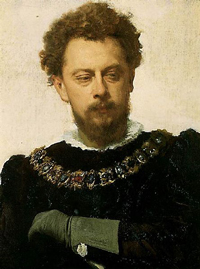A soliloquy is is a more specific kind of monologue. During a soliloquy, a character speaks thoughts out loud for the audience to hear. A soliloquy enhances the text by allowing us to enter the thoughts and intentions of a character. A soliloquy can reveal the personality traits, emotions, and possible motives of a character. A soliloquy might also show the resolution of a conflict or solution to a problem or might establish further action in the drama.
The Taming of the Shrew continues to reveal how Petruchio is going above and beyond in his efforts to “tame” Kate. As the newlywed couple makes their way to Petruchio’s house in Padua, Petruchio points out how bright the moon is. When Kate responds that it is not the moon but the sun that is shining, Petruchio stubbornly refuses to continue until she admits that it is the moon. He continues with these mind games (in some interpretations with a great sense of fun and good humor) until Kate, with no more energy or patience to resist him, breaks down and admits that he is right. After Kate’s concession, Petruchio withdraws his earlier claim and states that the moon is the sun after all. Later in the scene, we find Petruchio alone, and this is when he delivers the following soliloquy:

Source: Kramskoi Portret of A.P.Lensky, Ivan Kramskoi, Wikimedia
The Taming of the Shrew, Act IV, Scene 1
PETRUCHIO:
Thus have I politicly begun my reign,
And ’tis my hope to end successfully.
My falcon now is sharp and passing empty;
And till she stoop she must not be full-gorged,
For then she never looks upon her lure.
Another way I have to man my haggard,
To make her come and know her keeper’s call,
That is, to watch her, as we watch these kites
That bate and beat and will not be obedient.
She eat no meat to-day, nor none shall eat;
Last night she slept not, nor to-night she shall not;
As with the meat, some undeserved fault
I’ll find about the making of the bed;
And here I’ll fling the pillow, there the bolster,
This way the coverlet, another way the sheets:
Ay, and amid this hurly I intend
That all is done in reverend care of her;
And in conclusion she shall watch all night:
And if she chance to nod I’ll rail and brawl
And with the clamour keep her still awake.
This is a way to kill a wife with kindness;
And thus I’ll curb her mad and headstrong humour.
He that knows better how to tame a shrew,
Now let him speak: ’tis charity to show.
Exit
Having successfully whisked Kate away to his home, Petruchio thinks aloud to himself and explains his plan to “tame” Kate in the same way that a falconer trains a pet falcon. In other words, he is now her keeper. This overly macho behavior is meant to get a laugh from the audience, but it sounds rather serious. It is up to us to decide how serious Petruchio’s intentions are. Some may laugh at his tongue in cheek plan to “tame” Katharina, and others may be shocked at his callousness toward his new bride. Some critics believe the play manages to lampoon chauvinistic behavior and celebrate the quick wit and fiery spirit of its heroine. Others see the play as dated and in keeping with the times in which it was written. Thus, the monologues and soliloquies from this play are interpreted very differently in productions. The question remains, did Petruchio tame Katharina, or did Katharina tame Petruchio?
Let’s review how monologues and soliloquies are similar and how they differ. Drag and drop each characteristic of a monologue or soliloquy into the appropriate circle. If the characteristic is common to both types of speeches, drop it into the "Both" area below.
Now you should be able to tell the difference between monologues and soliloquies and understand how these conventions enhance dramatic text. You may also have fun predicting what’s going to happen after you read or hear them. Understanding these two conventions brings you one step closer to understanding how actors and actresses can interpret the same speech in wildly different ways.